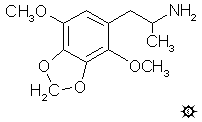- Language
- 🇺🇸
- Joined
- May 10, 2025
- Messages
- 192
- Reaction score
- 27
- Points
- 28
Another off-topic discourse of an example of a
propenylbenzene isomer ---->
Aromatic nitropropene
P.I.H.K.A.L.
SYNTHESIS: Apiole, as the crystalline essential oil 1-allyl-2,5-dimethoxy-3,4-methylenedioxybenzene, is isolated directly from commercial Oil of Parsley, by careful fractional distillation. It is the fraction that boils at 165-167 °C at 27 mm/Hg. A solution of 19.8 g apiole in a mixture of 43 g KOH and 60 mL hot EtOH was heated in the steam bath for 24 h. With vigorous stirring, it was diluted with H2O, at a rate which the crystals that formed spontaneously could accumulate from the turbidity that was generated. When no more H2O could be added (there was persistent oiling out of material) the reaction mixture was filtered to give 12.1 g of an amber solid material. This was recrystallized from 20 mL boiling hexane, which was filtered while hot to remove insolubles. From the cooled filtrate, there was obtained 9.3 g of 2,5-dimethoxy-3,4-methylenedioxy-1-propenylbenzene, isoapiole, as pale cream-colored solids.
A stirred solution of 8.8 g 2,5-dimethoxy-3,4-methylenedioxy-1-propenylbenzene and 3.9 g pyridine in 45 mL acetone was cooled to ice-bath temperatures, and treated with 7.9 g tetranitromethane. This extremely dark reac-tion was stirred at 0 °C for 5 min, then quenched with a solution of 2.6 g KOH in 45 mL H2O. With continued stirring, there appeared yellow crystals of 1-(2,5-dimethoxy-3,4-methylenedioxyphenyl)-2-nitropropene which, after filtering, washing with 50% acetone and air drying, weighed 8.0 g and had a mp of 110-111 °C.
The same procedure with Oil of Dill :
#59 DMMDA-2
2,3-DIMETHOXY-4,5-METHYLENEDIOXYAMPHETAMINE
[3D .mol structure]
DOSAGE: about 50 mg.
DURATION: unknown.
QUALITATIVE COMMENTS: (with 50 mg) I am into it; it is much like MDA.
EXTENSIONS AND COMMENTARY: This is pretty sparse information upon which to build a picture of biological activity. First, the synthesis was done by someone else and, as I have not been able to find where the notes are, this will be the one recipe in the footnote without explicit directions incorporated.
The procedure used was exactly the same as that described for DMMDA, except that the starting material was dillapiole rather than apiole. The dillapiole was obtained by the careful fractionation of Oil of Dill (as opposed to the isolation of apiole from the careful fractionation of Oil of Parsley). Isomerization to isodillapiole, nitration with tetra-nitromethane to give 1-(2,3-dimethoxy-4,5-methylenedioxyphenyl)-2-nitropropene, and its reduction with LAH in ether to give 2,3-dimethoxy-4,5-methylenedioxyamphetamine hydrochloride (DMMDA-2) proceeded in a precisely analogous manner to the preparation of DMMDA.
There's a Beeee going off-roading with a relative discourse
propenylbenzene isomer ---->
Aromatic nitropropene
P.I.H.K.A.L.
#58 DMMDA
2,5-DIMETHOXY-3,4-METHYLENEDIOXYAMPHETAMINESYNTHESIS: Apiole, as the crystalline essential oil 1-allyl-2,5-dimethoxy-3,4-methylenedioxybenzene, is isolated directly from commercial Oil of Parsley, by careful fractional distillation. It is the fraction that boils at 165-167 °C at 27 mm/Hg. A solution of 19.8 g apiole in a mixture of 43 g KOH and 60 mL hot EtOH was heated in the steam bath for 24 h. With vigorous stirring, it was diluted with H2O, at a rate which the crystals that formed spontaneously could accumulate from the turbidity that was generated. When no more H2O could be added (there was persistent oiling out of material) the reaction mixture was filtered to give 12.1 g of an amber solid material. This was recrystallized from 20 mL boiling hexane, which was filtered while hot to remove insolubles. From the cooled filtrate, there was obtained 9.3 g of 2,5-dimethoxy-3,4-methylenedioxy-1-propenylbenzene, isoapiole, as pale cream-colored solids.
A stirred solution of 8.8 g 2,5-dimethoxy-3,4-methylenedioxy-1-propenylbenzene and 3.9 g pyridine in 45 mL acetone was cooled to ice-bath temperatures, and treated with 7.9 g tetranitromethane. This extremely dark reac-tion was stirred at 0 °C for 5 min, then quenched with a solution of 2.6 g KOH in 45 mL H2O. With continued stirring, there appeared yellow crystals of 1-(2,5-dimethoxy-3,4-methylenedioxyphenyl)-2-nitropropene which, after filtering, washing with 50% acetone and air drying, weighed 8.0 g and had a mp of 110-111 °C.
The same procedure with Oil of Dill :
#59 DMMDA-2
2,3-DIMETHOXY-4,5-METHYLENEDIOXYAMPHETAMINE
[3D .mol structure]
DOSAGE: about 50 mg.
DURATION: unknown.
QUALITATIVE COMMENTS: (with 50 mg) I am into it; it is much like MDA.
EXTENSIONS AND COMMENTARY: This is pretty sparse information upon which to build a picture of biological activity. First, the synthesis was done by someone else and, as I have not been able to find where the notes are, this will be the one recipe in the footnote without explicit directions incorporated.
The procedure used was exactly the same as that described for DMMDA, except that the starting material was dillapiole rather than apiole. The dillapiole was obtained by the careful fractionation of Oil of Dill (as opposed to the isolation of apiole from the careful fractionation of Oil of Parsley). Isomerization to isodillapiole, nitration with tetra-nitromethane to give 1-(2,3-dimethoxy-4,5-methylenedioxyphenyl)-2-nitropropene, and its reduction with LAH in ether to give 2,3-dimethoxy-4,5-methylenedioxyamphetamine hydrochloride (DMMDA-2) proceeded in a precisely analogous manner to the preparation of DMMDA.
There's a Beeee going off-roading with a relative discourse










